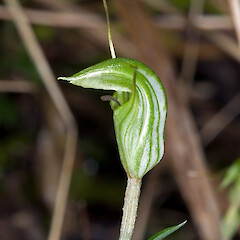Pterostylis alobula
Common name
greenhood
Synonyms
Pterostylis trullifolia var. alobula Hatch; Pterostylis crypta Nicholls Diplodium alobulum (Hatch) D.L.Jones, Molloy et M.A.Clem.
Family
Orchidaceae
Flora category
Vascular – Native
Endemic taxon
Yes
Endemic genus
No
Endemic family
No
Structural class
Orchids
NVS code
The National Vegetation Survey (NVS) Databank is a physical archive and electronic databank containing records of over 94,000 vegetation survey plots - including data from over 19,000 permanent plots. NVS maintains a standard set of species code abbreviations that correspond to standard scientific plant names from the Ngä Tipu o Aotearoa - New Zealand Plants database.
DIPALO
Chromosome number
2n = c.50
Current conservation status
The conservation status of all known New Zealand vascular plant taxa at the rank of species and below were reassessed in 2017 using the New Zealand Threat Classification System (NZTCS) – more information about this can be found on the NZTCS website. This report includes a statistical summary and brief notes on changes since 2012 and replaces all previous NZTCS lists for vascular plants.
Please note, threat classifications are often suggested by authors when publications fall between NZTCS assessment periods – an interim threat classification status has not been assessed by the NZTCS panel.
- Conservation status of New Zealand indigenous vascular plants, 2017 . 2018. Peter J. de Lange, Jeremy R. Rolfe, John W. Barkla, Shannel P. Courtney, Paul D. Champion, Leon R. Perrie, Sarah M. Beadel, Kerry A. Ford, Ilse Breitwieser, Ines Schönberger, Rowan Hindmarsh-Walls, Peter B. Heenan and Kate Ladley. Department of Conservation. Source: NZTCS and licensed by DOC for reuse under the Creative Commons Attribution 4.0 International licence.
2017 | Not Threatened
Previous conservation statuses
2012 | Not Threatened
2009 | Not Threatened
2004 | Not Threatened
Distribution
Endemic. New Zealand: Manawatāwhi / Three Kings Islands, Poor Knights Islands, North Island, South Island (in the east as far south as South Canterbury and the lower Waitaki Valley, and in the west as far south as Cape Foulwind), Chatham Islands.
Habitat
Coastal to montane (up to 1100 m a.s.l.). Usually on the forest floor in sparse leaf litter, open clay pans under scrub or amongst mosses in semi-shaded successional forest. Occasional invades rough pasture and lawns bordering forest remnants. Often growing with Pterostylis trullifolia.
Detailed description
Terrestrial, colony forming, perennial herb. Plants at flowering up to 150 mm tall. Stem green or reddish-green, slender, terete, smooth; internodes rarely > leaves. Petiolate leaves in separate loose rosette or more or less loosely spaced up the lower part of flowering stem; petiole up to 10 mm long, initially distinct soon merging into leaf lamina on lower cauline leaves; leaf lamina 5–15 × 4–15 mm, dark green or green, broad-ovate, orbicular-cordate to trowel-shaped, apex acute to subacute, upper leaf surface smooth. Cauline leaves 2–6, mostly all sessile, 5–25 × 3–6 mm, dark green to green, linear to narrow-lanceolate or narrow-elliptic, uppermost slightly overtopping ovary. Flower 1–(2) erect, pale green and white striped. Dorsal sepal 20–25 mm tall, apex acuminate, usually horizontal. Lateral sepals diverging at a wide angle to form a V shape when viewed from the front, sinus smoothly rounded and not jugate in side view, tips long-caudate and much overtopping galea. Petals almost as long as dorsal sepal, with the exposed marginal strip of medium width, and often nearly horizontal. Labellum arched and protruding, basal portion lanceolate, gradually tapering to mid-length, then abruptly contracted; margins recurved such that distal third is linear in outline and deeply channelled beneath, apex bluntly truncate. Column shorter than labellum; stigma elliptic, slightly prominent.
Manaaki Whenua Online Interactive Key
Similar taxa
Most often confused with Pterostylis trullifolia, with which it often grows. From that species it is easily distinguished by the presence of loose rosettes, or their complete absence, and that the rosette leaves have smooth rather than embossed surfaces. The flowers of P. alobula are bigger and usually paler green coloured than P. trullifolia. The lateral sepals when in side view are smooth and rounded, lacking the jugate shape typical of P. alveata, P. brumalis. and P. trullifolia.
Flowering
March–November
Flower colours
Green, White
Fruiting
May–January
Life cycle
Minute seeds are wind dispersed (Thorsen et al., 2009).
Propagation technique
Difficult—should not be removed from the wild.
Etymology
pterostylis: Winged column
Where To Buy
Not commercially available
TAXONOMIC NOTES
Jane et al. (2010) following a thorough rDNA (ITS) based analysis of the segregate genera erected for Pterostylis R.Br. by Szlachekto (2001) and Jones et al. (2002) found no support to continue their recognition. This view is followed here.
Attribution
Description adapted from Moore and Edgar (1970)
References and further reading
Janes JK, Duretto MF. 2010. A new classification for subtribe Pterostylidinae (Orchidaceae), reaffirming Pterostylis in the broad sense. Australian Systematic Botany 23: 260–269. https://doi.org/10.1071/SB09052.
Jones DL, Clements MA, Molloy BPJ. 2002. A Synopsis of the Subtribe Pterostylidinae. Australian Orchid Research 4: 129–146.
Moore LB, Edgar E. 1970. Flora of New Zealand, Volume II. Indigenous Tracheophyta: Monocotyledones except Gramineae. Government Printer, Wellington, NZ. 354 p.
Szlachekto, D.L. 2001: Genera et Species Orchidalium 1. Polish Botanical Journal 46(1): 11–26.
Thorsen MJ, Dickinson KJM, Seddon PJ. 2009. Seed dispersal systems in the New Zealand flora. Perspectives in Plant Ecology, Evolution and Systematics 11: 285–309. https://doi.org/10.1016/j.ppees.2009.06.001.











